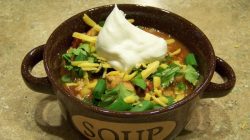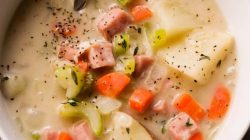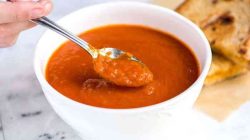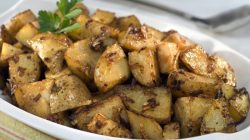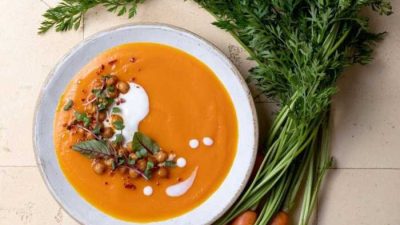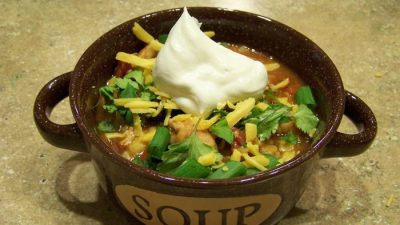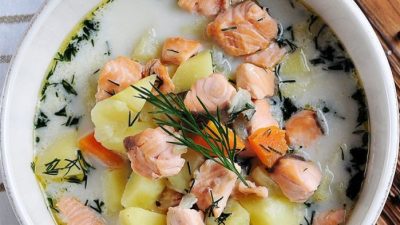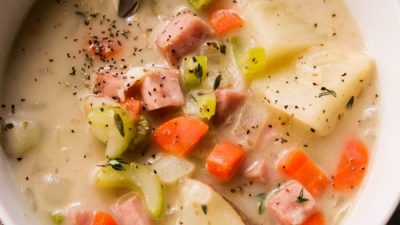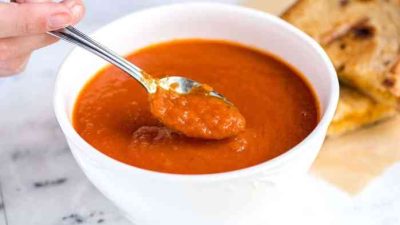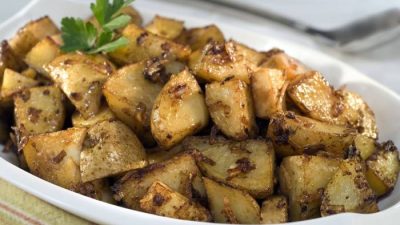Pea and Ham Soup Recipe Variations: Pea & Ham Soup Slow Cooker Recipe
Pea & ham soup slow cooker recipe – This section explores the delightful versatility of pea and ham soup by showcasing three variations, each utilizing a different type of ham to create unique flavor profiles and textures. We will also delve into alternative pea options and discuss the impact of these ingredient choices on the overall soup experience.
Recipe Variations Using Different Ham Types

Source: readersdigest.ca
| Recipe Name | Ham Type | Key Ingredients | Special Notes |
|---|---|---|---|
| Smoked Ham Hock Soup | Smoked Ham Hock | Smoked ham hock, dried split peas, carrots, celery, onion, vegetable broth, bay leaf, thyme | The ham hock imparts a deep, smoky flavor and rich texture to the broth. Simmering the hock for a longer period extracts maximum flavor. |
| Classic Pea and Diced Ham Soup | Diced Ham | Diced ham, fresh or frozen peas, potatoes, carrots, celery, onion, chicken broth, parsley, black pepper | This version offers a quicker cooking time and a more readily available ham option. The diced ham blends seamlessly into the soup. |
| Spiral-Cut Ham Soup | Spiral-Cut Ham | Spiral-cut ham (leftovers), green peas, leeks, potatoes, vegetable broth, white wine (optional), fresh dill | Using leftover spiral-cut ham adds a sweet and savory note. The ham’s inherent moisture contributes to the soup’s overall richness. The leeks provide a delicate onion flavor. |
The choice of ham significantly impacts the soup’s taste and texture. Smoked ham hock delivers a robust, smoky flavor and a rich, gelatinous broth. Diced ham provides a more balanced, savory taste, while spiral-cut ham offers a sweeter, milder profile. The texture also varies: ham hock yields a thicker, more substantial soup due to the collagen released during cooking, while diced ham integrates more evenly, and spiral-cut ham contributes smaller, more tender pieces.
Fresh or frozen peas can be used interchangeably. Fresh peas offer a brighter, sweeter flavor and a slightly firmer texture, while frozen peas are convenient and maintain their nutritional value. If using frozen peas, add them towards the end of the cooking time to prevent overcooking and mushiness.
Slow Cooker Techniques for Pea and Ham Soup
Mastering slow cooker techniques ensures a perfectly balanced pea and ham soup, avoiding overly mushy vegetables or a watery broth. This section provides a step-by-step guide and crucial tips for achieving optimal results, regardless of your slow cooker’s size.
Optimal Cooking Time and Temperature, Pea & ham soup slow cooker recipe
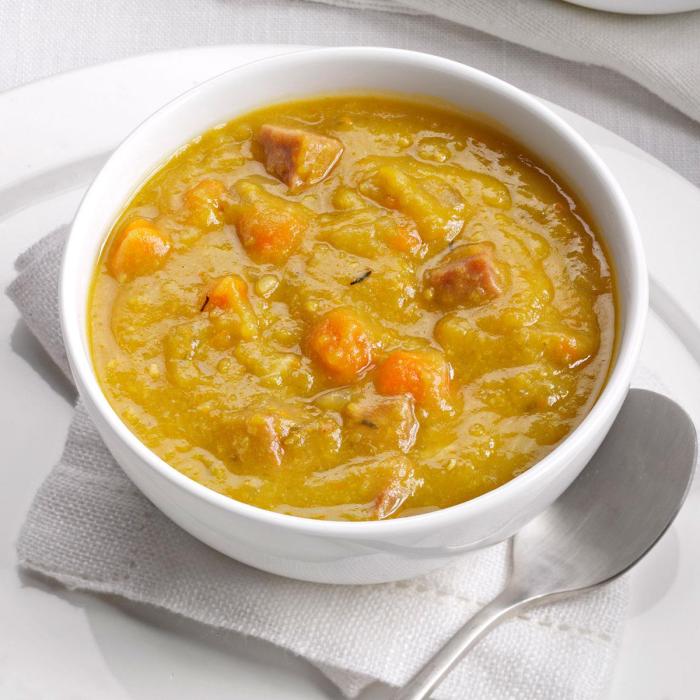
Source: tmbi.com
The optimal cooking time for pea and ham soup in a slow cooker generally ranges from 6-8 hours on low or 3-4 hours on high. Larger slow cookers may require slightly longer cooking times to ensure the ingredients are fully cooked and the flavors have melded. Maintaining a low and slow cooking temperature prevents the soup from becoming overly mushy.
Preventing Mushy or Watery Soup
To prevent mushiness, add starchy vegetables like potatoes towards the middle of the cooking time. Avoid overfilling the slow cooker, leaving sufficient headspace to prevent boiling over. For a thicker consistency, consider adding a cornstarch slurry (1 tablespoon cornstarch mixed with 2 tablespoons cold water) during the last 30 minutes of cooking. To avoid a watery soup, ensure the ham is not overly lean and that sufficient broth is used, but not excessive.
Properly browning the ham before adding it to the slow cooker also contributes to a richer broth.
Step-by-Step Slow Cooker Preparation
- Brown the ham (if using a ham hock or bone-in ham) in a skillet over medium-high heat until lightly browned. This step enhances the flavor of the soup.
- Add the browned ham, chopped vegetables (onions, carrots, celery), and dried peas (if using) to the slow cooker.
- Pour in the broth, add any herbs and spices, and stir well to combine.
- Cook on low for 6-8 hours or on high for 3-4 hours, or until the peas are tender and the ham is easily shredded.
- Shred the ham and stir it back into the soup. If using frozen peas, add them during the last 30 minutes of cooking.
- Season to taste with salt and pepper.
Ingredient Selection and Preparation
Choosing high-quality ingredients and preparing them correctly significantly impacts the final taste and texture of your pea and ham soup. This section details essential ingredients and provides guidance on proper preparation techniques.
Essential Ingredients and Quantities
- 1 lb ham bone-in (ham hock, butt, or shank), or 1 cup diced ham
- 1 cup dried split peas, or 2 cups frozen peas
- 1 large onion, chopped
- 2 carrots, chopped
- 2 celery stalks, chopped
- 6 cups vegetable or chicken broth
- 1 bay leaf
- 1 tsp dried thyme
- Salt and pepper to taste
Proper preparation is crucial. Browning the ham before adding it to the slow cooker intensifies its flavor. Chopping vegetables into uniform sizes ensures even cooking. Soaking dried peas for at least an hour (or overnight) before cooking shortens cooking time and improves texture. Using fresh ingredients often results in a brighter, more vibrant flavor compared to canned options, although canned ingredients offer convenience.
Flavor Enhancement and Customization
This section provides guidance on enhancing the flavor profile of your pea and ham soup using various herbs, spices, and additional ingredients. Adjusting seasonings allows you to create a heartier or lighter version to suit your preferences.
Herbs and Spices
| Herb/Spice | Amount | Flavor Profile | Usage Notes |
|---|---|---|---|
| Bay Leaf | 1-2 | Earthy, slightly sweet | Remove before serving. |
| Thyme | 1 tsp | Earthy, slightly lemony | Adds depth and complexity. |
| Black Pepper | To taste | Spicy, pungent | Use freshly ground for best results. |
| Rosemary | 1 sprig | Woody, aromatic | Pairs well with ham. |
Adding vegetables like potatoes, leeks, or parsnips increases the nutritional value and adds textural complexity. For a heartier soup, use more ham and starchy vegetables. A lighter version can be achieved by using less ham and broth, and incorporating more fresh vegetables. Adjusting the amount of salt and pepper allows for personalized seasoning.
Serving Suggestions and Presentation
This section provides ideas for serving and presenting your pea and ham soup in an attractive and appealing manner.
Serving Styles and Garnishes
- Classic: Serve hot in a bowl, garnished with a sprinkle of fresh parsley or chives.
- Rustic: Serve in a bread bowl, topped with a dollop of sour cream or crème fraîche.
- Elevated: Serve in elegant bowls, garnished with crispy fried onions and a drizzle of high-quality olive oil.
A visually appealing presentation involves considering color, texture, and visual appeal. The soup should have a rich, inviting color, with the peas and ham visible. The texture should be creamy and slightly chunky. Garnishes add visual interest and enhance the overall presentation. The bowls should be clean and simple, allowing the soup to be the focal point.
Recipe Card Image Description: A rustic bowl overflowing with a vibrant green pea and ham soup. The ham is visible in tender, shredded pieces, contrasting with the bright green peas. The broth appears creamy and rich, with a hint of steam rising from the surface. The overall impression is one of warmth, comfort, and deliciousness.
Storage and Reheating
Proper storage and reheating methods preserve the quality and flavor of your leftover pea and ham soup.
Storage and Reheating Methods
Store leftover soup in airtight containers in the refrigerator for up to 3 days or in the freezer for up to 3 months. To reheat, gently warm on the stovetop over low heat, stirring occasionally to prevent sticking. Alternatively, microwave in short bursts, stirring between each burst to ensure even heating. Stovetop reheating generally preserves the soup’s texture and flavor better than microwaving, which can sometimes make the soup watery.
For a comforting meal, a pea and ham soup slow cooker recipe is hard to beat. The ease of slow cooking allows for maximum flavor development, unlike some recipes. If you’re looking for a hearty main course to complement it, you might consider a different approach, such as the original Lipton onion soup meatloaf recipe 2 lbs , which offers a savory counterpoint.
Then, after enjoying your meatloaf, return to the soothing simplicity of that delicious pea and ham soup.
While both methods are viable, stovetop reheating tends to maintain a smoother texture and prevent the soup from becoming overly hot in spots, as can sometimes happen with microwave reheating. The flavor profile is generally better preserved with stovetop reheating, avoiding any potential “microwave effect” on delicate flavors.
Common Queries
Can I use leftover cooked ham?
Absolutely! Leftover cooked ham works perfectly, just chop it into bite-sized pieces before adding it to the slow cooker.
How long can I store leftover soup?
Store leftover soup in an airtight container in the refrigerator for up to 3 days or in the freezer for up to 3 months.
What if my soup is too watery?
Simmer the soup uncovered on the stovetop for 15-20 minutes to reduce excess liquid. You can also add a cornstarch slurry (1 tablespoon cornstarch mixed with 2 tablespoons cold water) to thicken it.
Can I use different vegetables?
Yes! Carrots, celery, potatoes, and leeks are all excellent additions. Feel free to experiment with your favorite vegetables.


